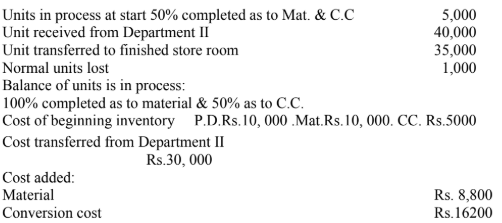CSS Accountancy & Auditing Past Paper 2019
Paper-I (Subjective) 80 Marks
Attempt ONLY FOUR questions from Paper-I PART-II by selecting TWO questions from EACH SECTION. (20×4)
SECTION – I
Q. No. 2. Some amounts are omitted in each of the following financial statements.
XY. Co.
Total assets —————- Rs. 37,500
Total liabilities ————— ?
Common stock ————– 2,500
Retained earnings ———- 13,500
Revenue ——————– 24,000
Expenses ——————— ?
Retained earnings, Jan. 1 —- ?
Net income —————- 7,500
Dividends —————- 6,000
Retained earnings, Dec. 31 ——– 13,500
Instruction: Determine the missing amounts.
Q. No. 3. (a) Burno Co. purchased equipment on Jan. 1, 2005 at a total invoice cost of Rs.280,000, additional costs of Rs.5,000 for freight and Rs.25,000 for installation were incurred. The equipment has an estimated salvage value of Rs.10,000 and an estimated useful life of five years. What is the amount of
accumulated depreciation at Dec. 31,2006 if the straight-line method of depreciation is used?
(b) A plant asset cost Rs.27,000 when it was purchased on Jan. 1, 2008. It was depreciated by the straight-line method based on a 9-year life with no salvage value. On June 30, 2008, the asset was discarded with no cash proceeds. What gain or loss should be recognized on the retirement? Pass the entry.
(c) On June 30, 2010 B. Co. sells office furniture for Rs.60,000 cash. The office furniture originally cost Rs.150,000 when purchased on Jan 1, 2005. Depreciation is recorded by the straight-line method over 10 years with a Salvage value of Rs.15,000.
Q. No. 4. The balance sheet of AB Ltd. is as under:

Required:
Compute the following:
1. Working capital
2. Current ratio
3. Quick or liquid ratio
4. Super quick ratio
SECTION – II
Q. No. 5. The AB & Co produces a chemical which requires processing in three departments.
The following is the data to the operation of department III for September, 2008.

Required: Prepare cost of production report of Department III by Weighted Average.
Q. No. 6. (a) K Co. was totally destroyed by fire during June. However, certain fragments
of its cost records with the following data were recovered: idle capacity
variance, Rs.1,266 favorable; spending variance, Rs.879 unfavorable; and
applied factory overhead Rs.16, 234.
Required:
Determine (1) The budget allowance, based on capacity utilized, and (2) the
actual factory overhead.
(b) A Co. uses 100% Bonus plan with a wage rate of Rs.20 per hour and the
standard production is 40 units per hour. Bonus will be given for the time
saved. Following is the data of Mr. X:
—————-Units produced
Monday————- 360
Tuesday————- 400
Wednesday———- 350
Required: Determine Mr. X’s total earning, the time saved, daily earnings and
the labor cost per unit.
Q. No. 7. ABC Company’s most recent contribution format income statement is shown below:

Required:
Prepare a new contribution format income statement under each of the following conditions.
(a) Sales volume increases by 15%.
(b) Selling price decreases by $1.5 per unit, and sales volume increases by 25%.
(c) Selling price increases by $1.5 per unit, fixed expenses increases by $20,000 and the sales volume decreases by 5%.
(d) Selling price increases by 12%, variable expense increases by 60% per unit and sales volume decreases by 10 %.
Q. No.8. The following information is gathered from the labor records of Binamul & Co. Payroll allocation for direct labor is Rs. 1, 31,600.
Time card analysis shows that 9,400 hours were worked on productions lines.
Production reports for the period showed that 4,500 units have been completed, each having standard labor time of 2 hours and a standard labor rate of Rs. 15 per hour. Calculate the labor variances.
Paper-II (Subjective) 80 Marks
Attempt ONLY FOUR questions from Paper-II PART-II by selecting at least ONE question from EACH SECTION. (20×4)
SECTION – I (AUDITING)
Q. 2. Explain shortly all audit assertions related to class of transactions (revenue and expenses), account balances (assets/liabilities/equities), and presentation & disclosure.
Q. 3. Define and explain different types of audit risks. How these risks are used to manage the audit assignment.
Q. 4. What are Computer Assisted Audit Techniques (CAATs) that can be used in e-commerce environment.
SECTION – II (BUSINESS TAXATION)
Q. 5. (a) Explain the concept of input tax, output tax, zero rated supply, exempt supply and input tax credit.
(b) From the following data, calculate the tax payable by Mr. Aslam for the year ended 30th June 2018:
(i) Salary Rs. 19,500 pm.
(ii) Special pay Rs. 3,000 p.m
(iii) Bonus for the year Rs. 38,000.
(iv) Conveyance allowance Rs. 1,500 p.m
(v) Free accommodation provided by the employer. He was entitled to a house
allowance of Rs. 72,000.
(vi) Medical expenses reimbursed by his employer under the contract of
employment Rs. 24,000.
(vii) Zakat paid under Zakat Ordinance during the year Rs. 11,300.
(viii) Donation to approved charitable institutions under section 61 Rs. 15,000.
(ix) Legal expenses during the year Rs. 6,000.
(x) Amount paid for approved pension scheme during the year Rs. 90,000.
(xi) Shares of listed companies purchased Rs. 6,000.
Q. 6. (a) What deductions are not allowed to be deducted before arriving at the taxable profits of a business?
(b) Mr. Mohammad Adil received the following emoluments during the year ended 30th June 2018.

Notes
(i) Mr. Mohammad Adil received an interest free loan of Rs. 12,00,000 from his employer on 01.07.2017.
(ii) His employer has provided him a new car to be used for personal and official purposes. The car costs the employer Rs. 15,00,000.
Required: Calculate the tax payable by Mr. Mohammad Adil.
SECTION – III (BUSINESS STUDIES AND FINANCE)
Q. 7. (a) Explain Yield To Maturity (YTM), its calculation, and the procedure used to value bonds that pay interest semiannually.
(b) Joan Messineo borrowed $15,000 at a 14% annual rate of interest to be repaid over 3 years. The loan is amortized into three equal, annual, end-of-year payments.
(i) Calculate the annual, end-of-year loan payment.
(ii) Prepare a loan amortization schedule showing the interest and principal breakdown of each of the three loan payments.
(iii) Explain why the interest portion of each payment declines with the passage oftime.
Q. 8. (a) Explain the relationships among financial decisions, return, risk and the firm’s value.
(b) Nicholson Roofing Materials, Inc., is considering two mutually exclusive projects, each with an initial investment of $150,000.
The company’s board of directors has set a maximum 4-year payback requirement and has set its cost of capital at 9%. The cash inflows associated with the two projects are shown in the following table:

(i) Calculate the payback period for each project.
(ii) Calculate the NPV of each project at 10%
(iii) Calculate the NPV of each project at 9%.
(iv) Derive the IRR of each project.
(v) Rank the projects by each of the techniques used. Make and justify a
recommendation.
